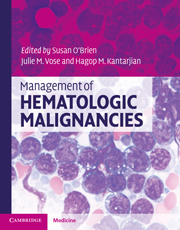Book contents
- Frontmatter
- Contents
- List of contributors
- 1 Molecular pathology of leukemia
- 2 Management of acute myeloid leukemia
- 3 Treatment of acute lymphoblastic leukemia (ALL) in adults
- 4 Chronic myeloid leukemia
- 5 Chronic lymphocytic leukemia/small lymphocytic lymphoma
- 6 Myelodysplastic syndromes (MDS)
- 7 Hairy cell leukemia
- 8 Acute promyelocytic leukemia: pathophysiology and clinical results update
- 9 Myeloproliferative neoplasms
- 10 Monoclonal gammopathy of undetermined significance, smoldering multiple myeloma, and multiple myeloma
- 11 Amyloidosis and other rare plasma cell dyscrasias
- 12 Waldenstrom's macroglobulinemia/lymphoplasmacytic lymphoma
- 13 WHO classification of lymphomas
- 14 Molecular pathology of lymphoma
- 15 International staging and response criteria for lymphomas
- 16 Treatment approach to diffuse large B-cell lymphomas
- 17 Mantle cell lymphoma
- 18 Follicular lymphomas
- 19 Hodgkin lymphoma: epidemiology, diagnosis, and treatment
- 20 Treatment approaches to MALT/marginal zone lymphoma
- 21 Peripheral T-cell lymphomas
- 22 Mycosis fungoides and Sézary syndrome
- 23 Central nervous system lymphoma
- 24 HIV-related lymphomas
- 25 Lymphoblastic lymphoma
- 26 Burkitt lymphoma
- Index
- References
19 - Hodgkin lymphoma: epidemiology, diagnosis, and treatment
Published online by Cambridge University Press: 10 January 2011
- Frontmatter
- Contents
- List of contributors
- 1 Molecular pathology of leukemia
- 2 Management of acute myeloid leukemia
- 3 Treatment of acute lymphoblastic leukemia (ALL) in adults
- 4 Chronic myeloid leukemia
- 5 Chronic lymphocytic leukemia/small lymphocytic lymphoma
- 6 Myelodysplastic syndromes (MDS)
- 7 Hairy cell leukemia
- 8 Acute promyelocytic leukemia: pathophysiology and clinical results update
- 9 Myeloproliferative neoplasms
- 10 Monoclonal gammopathy of undetermined significance, smoldering multiple myeloma, and multiple myeloma
- 11 Amyloidosis and other rare plasma cell dyscrasias
- 12 Waldenstrom's macroglobulinemia/lymphoplasmacytic lymphoma
- 13 WHO classification of lymphomas
- 14 Molecular pathology of lymphoma
- 15 International staging and response criteria for lymphomas
- 16 Treatment approach to diffuse large B-cell lymphomas
- 17 Mantle cell lymphoma
- 18 Follicular lymphomas
- 19 Hodgkin lymphoma: epidemiology, diagnosis, and treatment
- 20 Treatment approaches to MALT/marginal zone lymphoma
- 21 Peripheral T-cell lymphomas
- 22 Mycosis fungoides and Sézary syndrome
- 23 Central nervous system lymphoma
- 24 HIV-related lymphomas
- 25 Lymphoblastic lymphoma
- 26 Burkitt lymphoma
- Index
- References
Summary
Introduction
Hodgkin disease/lymphoma is a malignancy with deep-rooted history. Thomas Hodgkin described the clinical history and post-mortem findings of lymphadenopathy and splenomegaly in six patients in 1832. In 1865, Sir Samuel Wilks published a second paper entitled “Cases of the enlargement of the lymphatic glands and spleen (or Hodgkin's disease) with remarks.” In that report, Wilks described a disease that may remain in the lymph nodes for years and is associated with anemia, fevers, and weight loss. Over the next 30 years, several physicians (W. S. Greenfield 1878, Carl Sternberg 1879, and Dorothy Reed 1902) provided the first pathologic descriptions of the characteristic malignant cells. Physicians initially believed that Hodgkin disease was caused by an infection, such as tuberculosis. Despite studies in the early twentieth century confirming the malignant nature of this disease, it has only been in the last 10–15 years that the malignant cells were shown to be derived from clonal B cells, hence the current World Health Organization (WHO) designation as “Hodgkin lymphoma.”
Prior to the 1960s, patients with advanced-stage Hodgkin lymphoma were typically treated with single-agent chemotherapy, resulting in a median survival of approximately 1 year and 5-year overall survival (OS) of < 5%. Major success in Hodgkin lymphoma has been achieved by radiation treatment and moreover by the development of multi-agent poly-chemotherapy. In 1950, Peters reported 70–80% 10-year OS rates for patients with stage I disease treated with high-dose, fractionated radiation therapy (RT).
- Type
- Chapter
- Information
- Management of Hematologic Malignancies , pp. 367 - 403Publisher: Cambridge University PressPrint publication year: 2010



